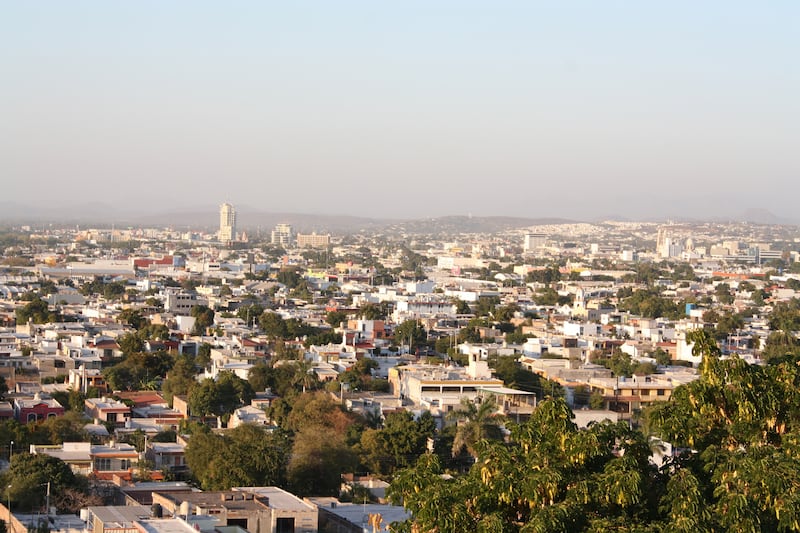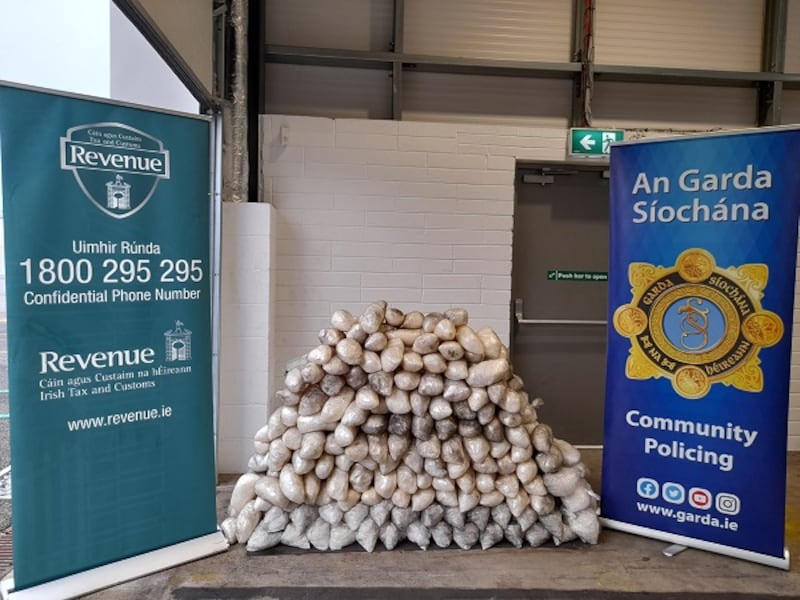The alleged senior role of an Irishman in one of the most powerful drugs cartels in the world has been brought into sharp focus following a half-tonne crystal meth seizure in Cork.
The authorities in Chile allege that Morris O’Shea Salazar (33) is a senior member of the notorious Mexican Sinaloa cartel, the crime gang known for the sheer scale of its reach across the globe and its brutality.
The Chileans claim O’Shea Salazar, who lived for a decade in Killorglin, Co Kerry, takes orders only from the cartel’s leaders. Known as the “Chapitos”, they are the sons of notorious “El Chapo” Joaquín Guzmán, whose life formed the basis of a Netflix Narcos series. O’Shea Salazar is now wanted in Chile for his alleged role in drug trafficking.
However, the Irish authorities believe he has remained active in Ireland, recruiting and directing agents or brokers here. Garda detectives strongly suspect he is linked to crystal meth valued at €32.8 million seized in Cork Port last Friday week.

O’Shea Salazar, the son of an Irish father and Mexican mother, spent his early childhood in Mexico. After his father was killed in a road traffic crash there the family relocated to Killorglin, his deceased father’s homeplace, around 2005.
He lived, with his mother, in Killorglin’s An Bhainseach housing estate, in a rented council house, and attended Killorglin Community College.
In his late teens he faced a litany of criminal charges, including possession of a firearm, criminal damage and handling stolen property. He was eventually sanctioned with a curfew and €1,000 fine.
It is unclear precisely when he left Killorglin. His next base was Barcelona. From there, the Chilean authorities allege, he directed drugs trafficking into Europe on behalf of the Sinaloa cartel, which he is linked to by family connections on his mother’s side.
The authorities in Chile late last year set out what they say is O’Shea Salazar’s alleged role in the Sinaloa cartel. At that time his mother, Yolanda Salazar Tarriba, and uncle, Ricardo Salazar Tarriba, were jailed for 10 and 15 years respectively for drug trafficking conspiracy unearthed in Chile in 2020 and 2021.
Chilean prosecutors alleged in court they were “instructed” by O’Shea Salazar as they were managing a scheme to source 6,000kg of cocaine in Bolivia. The drugs were intended to be stockpiled in Chile for export in six loads, by sea, to Antwerp port, Belgium, before being flown to Spain.
Although a Spanish undercover agent managed to reach O’Shea Salazar by phone in early 2021, a planned meeting between the two did not take place. The Irish-Mexican dual citizen, who called himself “Mauricio”, was not in Spain on the preferred date. After that call, O’Shea Salazar ceased contact with the agent.
His mother and uncle were then arrested in Chile in March 2021, as they were trying to leave the country. They were convicted of drugs trafficking last November and sentenced last December.
O’Shea Salazar is now wanted in Chile, where a formal extradition request was activated for him last July relating to the 6,000kg cocaine smuggling conspiracy. That haul was secured for about $9 million (€8.3 million) to $10 million (€9.2 million) at source in Bolivia but was worth €420 million on the streets of Europe. O’Shea Salazar remains at large, probably in Mexico.
The Chileans describe him as “an active member of the Sinaloa cartel” and “leader of the cell” that his uncle and mother were controlling in Chile. They added he was “operating or leading this cell of the cartel, at times from Europe and at other times from Mexico”.
Last Friday week gardaí found 546kg of crystal meth valued at €32.8 million, in a container in Cork Port. Garda sources have told The Irish Times the haul was shipped from Mexico, probably after being produced there in Sinaloa cartel-run laboratories. The consignment had been delivered to Ireland for forwarding to Australia.

The discovery of the drugs prompted a week of Garda searching, including in Cork, Kerry and Waterford city. Two firearms were seized and two men, aged in their 40s, arrested. Leaving aside the allegations against those men, gardaí believe the Sinaloa cartel has cultivated contacts in the Republic, including in Kerry, with O’Shea Salazar suspected of involvement.
Nathan P Jones, a US-based academic and author, whose work focuses on drugs trafficking from Mexico, says the Sinaloa and Jalisco New Generation (CJNG) Mexican cartels have been in a race for more than a decade to expand internationally. This has ramped up the trafficking of drugs into Europe, resulting in many large-scale consignments being discovered there, now including in Ireland.
“They are the two dominant players now, and they are reaching out all around the world trying to open up new markets, competing with each other,” said Jones, author of Mexico’s Illicit Drug Networks and the State Reaction and scholar in drug policy and Mexico studies at Rice University’s Baker Institute for Public Policy.
“The CJNG came on really strong . . . they didn’t exist before 2009-2010. But now they are the most geographically expanded Mexican cartel and the Sinaloa cartel is having to compete against them.”
Jones added that the recruitment of local brokers by the cartels, in territories they use as transit hubs for their trafficking, was “part of a consistent pattern we’ve seen over the last decade”. There may be a “transport logistics advantage” for the cartel in shipping consignments of drugs to Ireland.
[ New searches in Waterford after €32.8m Irish-Mexican crystal meth seizure in CorkOpens in new window ]
The cartel could pause a shipment in Ireland for a period before sending it on its way again, he said. In those circumstances, it would present to international law enforcement, including customs officials, as a completely new load making a new journey. Any cargo originating in Ireland, rather than Mexico, would be seen as lower risk.
He also believed someone with dual citizenship, such as O’Shea Salazar, was of “high value” to a Mexican cartel as they could move across Europe freely. Any long-term residence in a European country would also aid a cartel member’s ability to recruit agents or brokers there, he added.
Anne Milgram, the head of the US Drug Enforcement Administration (DEA), last year told the United States House Judiciary Subcommittee on Crime and Federal Government Surveillance the Sinaloa cartel was so powerful that its drugs trafficking had directly resulted in “the United States’ unprecedented fentanyl epidemic”.
“It has been identified that there are currently more than 26,000 members, associates, facilitators, and brokers affiliated with the [Sinaloa] cartel around the world,” she said.
Michael O’Sullivan is the former head of the Garda drug squad, a former assistant commissioner and was also head of Lisbon-based MAOC-N, the EU’s agency for combating maritime drug trafficking.
He believes many Irish people “simply don’t understand” the nature of the drugs trade, especially from the Mexican and Colombian perspective. O’Sullivan, who spent time in Sinaloa with DEA agents, said that it was “a vast area and the police don’t rule it”.
“They go around like an army,” he said of armed cartel members in convoys of all-terrain vehicles. “They’re in 4X4s going past the police. They’re small armies covering vast areas.”
He added that local people in Sinaloa “are not going to do what the government tells them”. Instead, rather than risking their lives by resisting the cartel, they work for them for more money that is available in any other job they might access. Whole regions were mired in a drug-producing culture, where the cartel was both employer and the law. Trying to convince those communities of the evils of producing cocaine “would be a bit like banning Guinness” in Ireland.
O’Sullivan added the scale of the ambition of the cartels – and their capacity and greed – was reflected in some of the drug-smuggling efforts thwarted in Europe. For example, 11-tonne loads of cocaine – 22 times larger in weight than the consignment found in Cork last week – had been seized.
O’Sullivan points to a 3.5-tonne shipment of cocaine that had been discovered in Spain’s northwestern Galicia region on a submarine in 2019. It had made a 23-day journey from South America.
He stressed that the cartels’ attention to detail, and the network of fixers and enablers they put in place, was not limited simply to moving drugs on ships; it also extended to those places where their drugs were transiting through, or were being offloaded for final delivery.
“They have got their representatives on the ground, their own people there to vouch for others and check [a drug delivery] isn’t an undercover sting, for example. You can’t be making a call to some guy on the docks in some place like Rotterdam,” said O’Sullivan.
“They don’t take a ‘pot luck’ approach at this. They have representatives on the ground, they have to. They’re too far away and there’s too much money involved.”
- See our new project Common Ground, Evolving Islands: Ireland & Britain
- Sign up for push alerts and have the best news, analysis and comment delivered directly to your phone
- Find The Irish Times on WhatsApp and stay up to date
- Our In The News podcast is now published daily – Find the latest episode here











